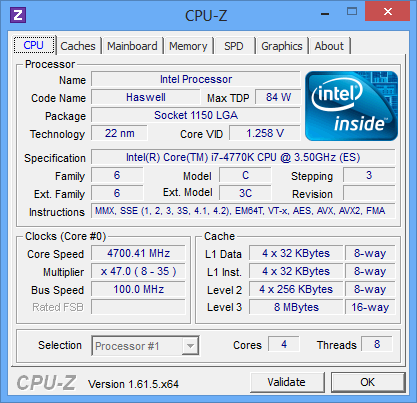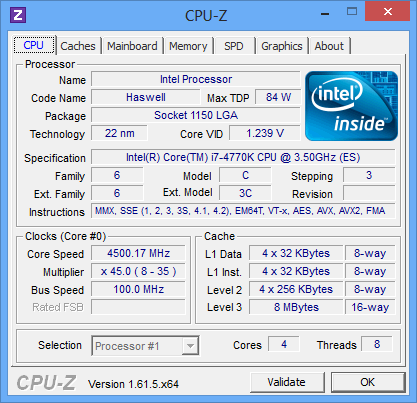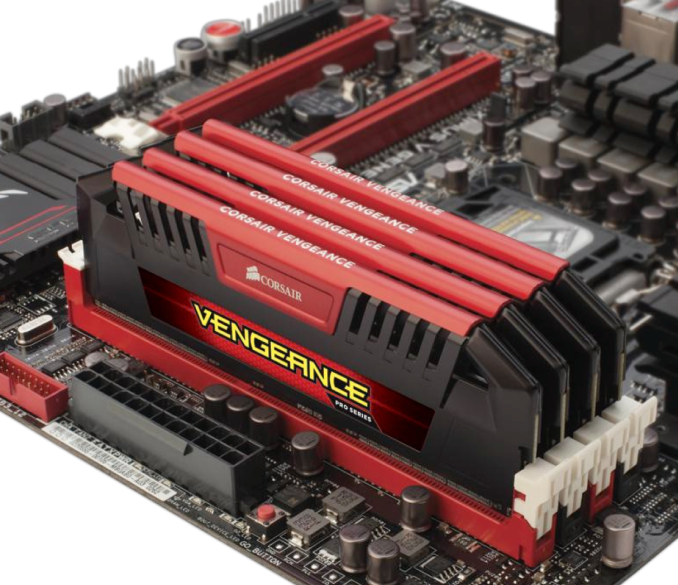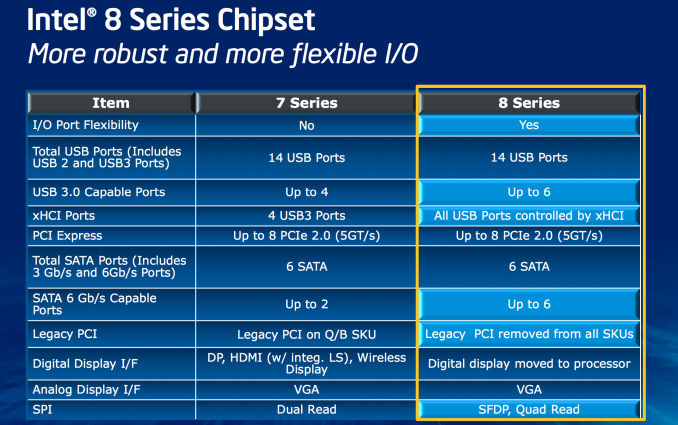The Haswell Review: Intel Core i7-4770K & i5-4670K Tested
by Anand Lal Shimpi on June 1, 2013 10:00 AM ESTMemory
Haswell got an updated memory controller that’s supposed to do a great job of running at very high frequencies. Corsair was kind enough to send over some of its Vengeance Pro memory with factory DDR3-2400 XMP profiles. I have to say, the experience was quite possibly the simplest memory overclocking I’ve ever encountered. Ivy Bridge was pretty decent at higher speeds, but Haswell is a different beast entirely.
Although I used DDR3-2400 for most of my testing, Corsair’s Vengeance Pro line is available in frequencies rated all the way up to 2933MHz.
Platform
Haswell features a new socket (LGA-1150). Fundamental changes to power delivery made it impossible to maintain backwards compatibility with existing LGA-1155 sockets. Alongside the new socket comes Intel’s new 8-series chipsets.
At a high level the 8-series chipsets bring support for up to six SATA 6Gbps and USB 3.0. It’s taken Intel far too long to move beyond two 6Gbps SATA ports, so this is a welcome change. With 8-series Intel also finally got rid of legacy PCI support.
Overclocking
Despite most of the voltage regulation being moved on-package, motherboards still expose all of the same voltage controls that you’re used to from previous platforms. Haswell’s FIVR does increase the thermal footprint of the chip itself, which is why TDPs went up from 77W to 84W at the high-end for LGA-1150 SKUs. Combine higher temperatures under the heatspreader with a more mobile focused chip design, and overclocking is going to depend on yield and luck of the draw more than it has in the past.
Haswell doesn’t change the overclocking limits put in place with Sandy Bridge. All CPUs are frequency locked, however K-series parts ship fully unlocked. A new addition is the ability to adjust BCLK to one of three pre-defined straps (100/125/167MHz). The BCLK adjustment gives you a little more flexibility when overclocking, but you still need a K-SKU to take advantage of the options.


In terms of overclocking success on standard air cooling you should expect anywhere from 4.3GHz - 4.7GHz at somewhere in the 1.2 - 1.35V range. At the higher end of that spectrum you need to be sure to invest in a good cooler as you’re more likely to bump into thermal limits if you’re running on stable settings.

















210 Comments
View All Comments
klmccaughey - Monday, June 3, 2013 - link
AMD are a damn sight closer on Nvidia than they are to Intel, though still sandbagging for this year. It's a bad year for us upgraders!aCuria - Saturday, June 1, 2013 - link
This review needs a compilation speed test against the 3930k, I would really like to know if haswell could edge out the 3930k in that testKevin G - Saturday, June 1, 2013 - link
Haswell met expectations in terms of IPC increases and power reductions. Both of those are good things overall. However, I feel disappointed and that comes down to how Intel has segregated their product line up: GT3e and TSX are only available on select parts. Ideally on the high end I'd like to get a socketed chip with an unlocked multiplier, GT3e, TSX, and Hyperthreading. Of those five criteria, at best I can get three of those. I suspect that this is due to Intel keeping several possible configurations reserved for their Xeon lineup but those chips won't have an unlocked multiplier.I'm currently an owner of a Sandybridge i7-2600K and the current performance of the Haswell parts aren't that tempting to jump the configurations Intel is selling. So I'm left waiting another year for a future desktop refresh before making the jump. Oh wait, Broadwell is going to be strictly a mobile refresh (and possibly a desktop BGA) refresh. So the best upgrade path for me for the next couple of years is to wait for a cheap i7-3770K on clearance. Otherwise the price/performance gains are radically higher as to not be worth it (also would need to get a new motherboard for socket 1150). I guess I'm left waiting for Skylake, get lucky that Intel adds several SKU's that I want or see what AMD can produce for the desktop.
Khato - Saturday, June 1, 2013 - link
Just curious as to your source for TSX only being available on select parts? The only place I saw that was on the Tom's Hardware preview. It's not in any of the reviews that I've seen?amock - Saturday, June 1, 2013 - link
According to http://ark.intel.com/products/75123/Intel-Core-i7-... the 4770k doesn't have TSX support.Kevin G - Saturday, June 1, 2013 - link
Intel is likely keeping TSX away from any desktop part with eDRAM. I suspect that having a massive L4 cache and TSX may make these quadcore chips very competitive with some of their socket 2011 parts based upon Sandy bridge/Ivy Bridge cores. These would happen in heavily memory bound applications like some database operations tend to be. Intel hasn't updated ARK with all of the Haswell chips yet so I'm be curious to see if their will be a mobile part with GT3e + TSX. I'd love it if some enterprise DB's supporting TSX were tested on this platform to see if this idea pans out.smilingcrow - Saturday, June 1, 2013 - link
The i5/i7 K series socketed desktop chips don't have eDRAM anyway so that's a moot point; they both lack TSX support.Kevin G - Monday, June 3, 2013 - link
Well it does look like that the L4 cache in GT3e parts can make Haswell competitive with socket 2011 six core chips. Check out the i7 4950hq results from Tech Report's Euler 3D fluid dynamics tests:http://techreport.com/review/24879/intel-core-i7-4...
The i7 4950 was likely seeing a strong benefit from an open air test bed (it is a mobile part) so I suspect that it can reach its 3.4 Ghz four core turbo relatively often. I still would expect slightly better performance if the 2.4 Ghz base clock was raised. The i7 4950 is further handicapped as the L3 cache was cut down to 6 MB and was using SO-DIMM memory with loose timings. The kicker is that this is with legacy code with any AVX2, FMA or TSX benefits.
I really, really want an unlocked, noncripppled socket 1150 part with GT3e.
just4U - Sunday, June 2, 2013 - link
Well.. your already on a i7.. and tbh I'd say the 2600K is better than the 3770K. .I purchased a 2700K even though the 3770K was out. Why? Well.. lower heat and miniscule gains in the 3X line.. plus when I decide to OC I'll likely get more out of my chip (as will you..) than they get on the IvyBridge processors.Kevin G - Monday, June 3, 2013 - link
I currently have my i7 2600K running at a conservative 4.2 Ghz. I've gotten it to boot at 4.6 Ghz with ease and probably could go further if felt like increasing voltages and got better cooling (though it is in a 4U server case so cooling options are a bit more limited).Price drops are happening for the i7 3770K. Probably need to wait a bit more and might pick one up if they drop further. Microcenter has dropped them to $230 already.